Hey everyone, Josh here. After playing several games of Khorne in AoS 2.0, I decided to write a 3 part series on Khorne and what all these new changes mean for us. This is part one, it’s all about what Khorne is and the core rules. Let’s dig in! For more tactics articles, check out the Tactics Corner!
Khorne Overview
Khorne seems to have settled as an army focused around support heros that stack buffs on large swaths of bloodthirsty daemons and warriors. Statistically speaking, Khorne’s units aren’t good by themselves, but with the help of Slaughterpriests, Bloodsecrators, Deathbringers, Command Traits and Artefacts hordes of Khornate units can make short work of their enemies.
Khorne tends to have the following themes associated with it’s units:
- Khorne hates magic and ranged combat. A huge number of units have some built in resistance to magic or are able to unbind spells in the same manner as a wizard. There is only one dedicated ranged unit in the entire army.
- Khorne love close combat. Units tend to favor high attack volume over high damage.
- Khorne loves buffing hit rolls. There are loads of ways to gain bonus to your hit rolls or deal mortal wounds if thresholds are made on hit rolls.
- Khorne loves granting bonuses to charge rolls. He wants to get you there.
- Khorne wants things to die. Yes, including your own units. There are very few defensive buffs in the army. There are also VERY few units with a 3+ save when compared to other armies.
- Khorne is not afraid of bloodshed. If you’re playing this army right, your units shouldn’t be afraid either.
Because Khorne has such a laser focus on wreckless combat, the strategies for this army typically revolve around getting into combat and alpha striking hard so that your opponent cannot hit you back in the same turn or sending swaths of units into combat to deal damage and gain the favor of khorne through blood. If this appeals to you, then let’s spill some blood.
The Core Rules & Khorne – Part 1
For the most part, the core rules have remained the same. I’m going to go over some of the rules that impact our army the most.
Coherency
The big one here is that if your unit is not in coherency at the end of a turn, then you need to pick a group of models within that unit that remain in coherency, leave those models on the field and remove the rest. In the past we could leave models behind to keep them within the range of a aura or tie up enemy units in combat. Picking and choosing your battles will be more difficult now.
Command Abilities
In the new edition we have access to a command point system. At the beginning of each turn you gain one, and you start the game with a point for each battalion you have in your list. There are also ways to gain them through list building as well as artefacts.
In the past only generals could use command abilities, but now any hero can exchange a command points for a generic command ability or use their own. Playing aggressively means our general will typically die before the final turn.
Being able to use command abilities without a designated general is a boon for us. This means that named characters will be more useful considering. In the past they couldn’t take a command trait. Now they no longer need to be your general to take advantage of a command ability.
The generic command abilities are new, and can now be used reactively:
- At the Double: After you’ve rolled to run, you can expend a command point to turn the die-roll into a 6. This is insane for units that can run and charge. It makes the Wrath of Khorne Bloodthirster’s command ability much more powerful.
- Forward to Victory: After you’ve rolled a charge, you can expend a command point to re-roll the charge. This is super important for us. Games are often determined on a failed charge. Dice drama is fun, but if a game is too swinging it can result in too many negative gaming experiences.
- Inspiring Presence: This is super strong for other armies, but not quite as good for our own. I can see using this if your bloodsecrator is killed and you’re unable to grant immunity to battleshock.
A single hero can use their command ability more than once. In some cases the abilities are cumulative buffs. GW has done a great job cleaning up any command abilities that are obviously too powerful by either replacing or rewording them (post FAQ). Khorne has a ton of heros heros with command abilities. I’m sure there are lots of ways that Khorne players can take advantage of this system.
Movement
Standard moves and charges have remained the same, but while piling In we can now move 3” as long as we remain touching the closest enemy model. This is great for hoarding armies like Khorne. In the past, touching a models base would lock it in place. This means that we can get more units in there and spill more blood. Keep in mind, you can still lock lock models in place by touching their base with more than 1 model. This is because if more than one enemy model is equidistant to the model piling in, then that model most pile in closer to all of those enemy models.
Ranged Attacks
You are now forced to shoot units you’re engaged with. This is great for us, because we love to engage in melee combat. Taking away choices from our opponents is a big deal.
Look Out, Sir! I’m typically not a fan of rules that you’re forced to remind your opponent of. You’re going to have to constantly remind your opponent that your hero is within 3” of a unit with 10+ models. Khorne likes hordes and heroes. This rule will likely deter your opponent from shooting your heroes. Very good considering our heroes are such an important part of our army.
Melee Attacks
Not much has changed for melee attacks. The sequences are largely the same. Wound types are identical. The only things that have changed are the forced allocation of attacks and the wound allocation sequence.
Attack Allocation: Players alternate selecting units to activate during the attack sequence. In the past you weren’t forced to allocate attacks. You could choose a unit to activate and opt not to allocate attacks to the enemy models. This is no longer the case, models must allocate all attacks possible after a pile-in (psst, you don’t have to move while piling in). This is good for us. Now you have to attack those darn wrathmongers when we fling them at your monster.
Wound Allocation: Wounds are now allocated one at a time and models are slain individually. This means that units like, Blood Warriors or Wrathmongers will interrupt the wound allocation sequence with their no respite or bloodfury abilities. For blood warriors, it will likely not make a difference, but for Wrathmongers your opponents models will gain additional attacks while attacking with them until the last Wrathmonger is slain.
Triumphs & Command Points
All of the abilities in the triumph table are great but don’t expect to gain triumphs too easily because players are now rewarded with command points for taking armies that 50+ pts below the list building threshold. I fully expect players to take advantage of this. Especially if they aren’t using a battalion. It’s going to save you from battleshock on turn one if your opponent has a way to do significant damage to your army on the first turn (before you’ve had a chance to acquire any command points or use abilities).
Terrain Rules
The Scenery Table has (for the most part) received a heavy nerf. This is a good thing. IMO, terrain rules shouldn’t cost you the game. How many times have you lost the game to mystical terrain? Here’s what I think of each:
- Damned: Suffer D3, re-roll hits of 1. Unless you’re looking to kill a unit for some blood tithe points, don’t bother, most of your units already allow you to re-roll failed hit rolls of 1.
- Arcane: +1 to casting and unbinding. I wish they didn’t mention the Wizards keyword here. Arcane terrain is useless to us.
- Inspiring: +1 Bravery, units within 1”. We don’t care about this. One word, Bloodsecrator.
- Deadly: On a 1, D3 mortal wounds to unit if you end movement here. This is a lot less scary than it used to be. I’m not as worried running through deadly terrain.
- Mystical: 6+ death save, models within 1”. This terrain was so stupid in the last edition. I’m so glad they changed it. Just remember, it references models and not units.
- Sinister: -1 Bravery, units within 1”. I love this, but we don’t care about bravery. Might be good to hang out by this kind of terrain.
Spells
Spells play a big role in AoS 2.0. In this article I’ll focus on the core/matched play rules, but in part 2 article I’ll talk all about the endless spells and artefacts of the realms.
The rule of one regarding spells is now built right into the core rules. We don’t really care, because (for the most part) we don’t cast spells. You can add allies (or Archeon) to cast spells, and there might be some legitimate reasons for doing so in certain lists, but for the most part the rule of one isn’t going to have an impact on Khorne.
Both mystic shield and arcane bolt have been nerfed heavily, Arcane bolt will only do 1 mortal wound on average (D3 on a 10+), and Mystic Shield no longer provides +1 to save rolls but instead allows you to reroll save rolls of 1. This will significantly reduce the power level of inexpensive wizards like grot shamans, or unit style wizards like Pink Horrors.
The new 30” unbinding range makes it MUCH easier to unbind spells. This means that a wide variety of our units that could already unbind spells are much better than they were. That said, endless spells need to be dispelled after being successfully cast. Units that can unbind in the same manner as a wizard aren’t able to dispel endless spells unless otherwise stated on their warscrolls.
Battleplans
This is completely new to the core rules. While First Blood is as simple as it gets; it’s still a nice way to get people started with AoS. The key takeaway here is that objective capture has been defined in the core rules. When playing khorne, you typically field a large number of models. These rules favor lists with high model counts.
Realm of Battle and Allegiance Ability Rules
Rules for the realms of battle and allegiance abilities are defined in the core rules now. The Realms of Battle are new, and there is a lot to go over so I’ll be going over them in part two! The Allegiance ability rules haven’t changed since GH2017, and are further defined in GH2018. I’ll be going over those in part 3!
And remember, Frontline Gaming sells gaming products at a discount, every day in their webcart!

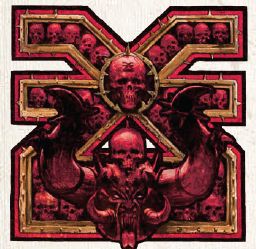
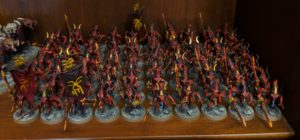
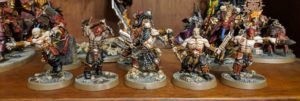
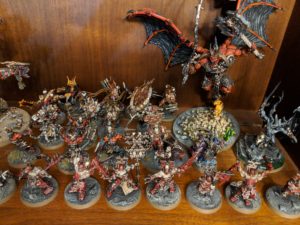
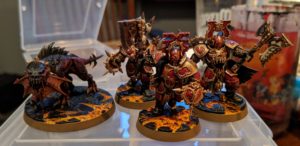

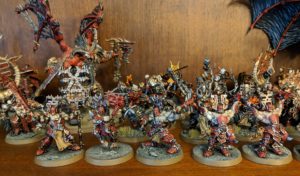

Great article, Josh! And man, your army looks great.
I can’t wait to try out Blades of Khorne in the new AoS.
Haven’t had a chance to play as much AoS2 as I’d like, but I’m loving what I have.
Really looking forward to these articles, Khorne’s in a really interesting place this edition. Big units for all those buffs or small for easy blood tithe summoning, hmmmmmmmm……
Yeah, i really dig their mechanics this edition. Feels very true to the lore and also like it will be quite good on the tabletop.
Great article, as always!